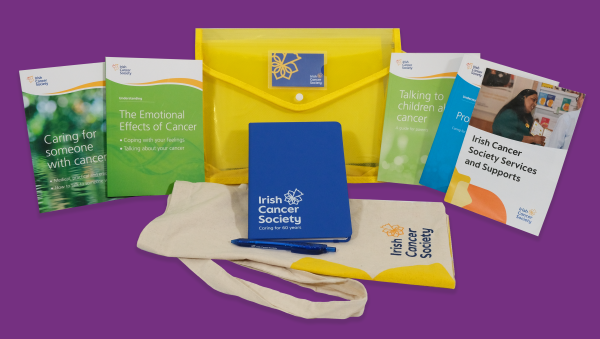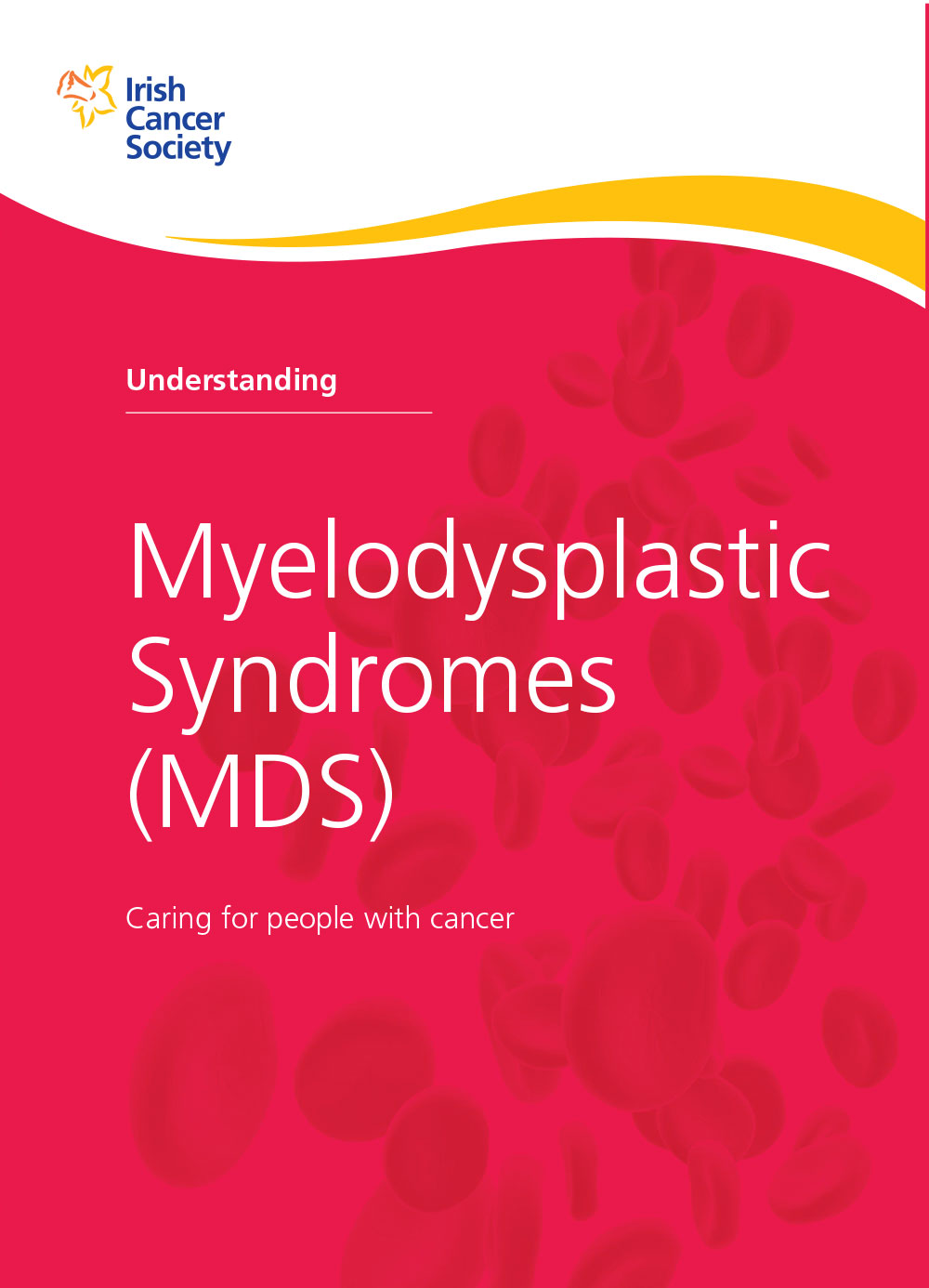Myelodysplastic syndromes (MDS)
Treatment
How is MDS treated?
The best treatment for you will depend on:
- Your [type of MDS and your IPSS-R score]
- How the disease is affecting you
- Your age and general fitness
- Your own wishes
You may not need active treatment if your MDS is not causing symptoms. In this case, you will have regular check-ups to monitor your condition, including blood count checks. If your disease changes, you can then start treatment. This is called active surveillance or watch and wait.
Types of treatment for MDS
Non-intensive treatment: Taking medication that may slow down the progress of MDS or improve your blood counts. It treats the disease with as few side-effects as possible.
Intensive chemotherapy: High doses of chemotherapy drugs to cure or control cancer.
Stem cell transplant: Replacing diseased cells with new healthy cells from a donor. This is the main treatment to possibly cure MDS, but only a small number of patients with MDS are suitable for this treatment.
Supportive care: Treatment to control the symptoms of MDS rather than cure it. For example, symptoms such as anaemia, infection and bleeding.
More about MDS treatments
The aim of non-intensive treatment is to slow down the progress of MDS. For example, if your blood counts are getting worse or if the disease is developing into leukaemia, you may benefit from treatment.
Non-intensive treatment aims to treat the disease with as few side-effects as possible, so your quality of life is less affected by side-effects of treatment. These treatments will not cure MDS but may change the disease.
Many of these treatments are new and often used as part of a clinical trial. They may be given as injections or tablets. These treatments are often drugs called targeted therapies. They include:
- Hypomethylating agents
Hypomethylating agents are drugs that affect the way certain genes inside a cell are controlled. Examples of this type of drug are azacitidine and decitabine. They can improve how your bone marrow works and delay leukaemia from developing in some patients. If you have high-risk MDS, they might increase how long you live. Side-effects include fever, nausea, constipation, diarrhoea, vomiting, leg swelling and pneumonia. - Lenalidomide
Lenalidomide works by acting on your body’s immune system to fight cancer. It is also known as immune modulation therapy. Lenalidomide is used for a subtype of MDS called the 5q minus syndrome. - Immunosuppressants
Immunosuppressants can sometimes help to improve blood counts for some types of MDS. For example ATG and Cyclosporin.
If you have high-risk MDS, you may benefit from intensive chemotherapy. Intensive chemotherapy uses high doses of drugs to try to clear the diseased cells from your bone marrow.
- Induction chemotherapy or remission induction stage
The first step in your treatment is an intense dosing of chemotherapy, which aims to get rid of all the diseased cells from your blood and bone marrow (remission). It usually involves 2 cycles of a combination of chemotherapy drugs. - Remission check
When the induction is over, you will have a bone marrow test to check if the MDS has gone into remission. - Consolidation or intensification stage
If you are in remission you may have 2 or 3 more cycles of less intense chemotherapy. This is to make sure that any remaining MDS cells are destroyed. Once the diseased cells are gone, it is called remission.
You will need to stay in hospital for about 4‒6 weeks for each treatment block. A small number of people might stay in remission for a long time after intensive chemotherapy, although usually when a donor is available, a stem cell transplant will follow.
Intensive chemotherapy is sometimes also used when preparing for a transplant. It can reduce the amount of MDS cells in your bone marrow before the transplant.
Read more about chemotherapy and its side-effects.
A stem cell transplant offers the chance of curing MDS. A transplant works by destroying all the blood cells in your bone marrow and replacing them with healthy stem cells via a transfusion into your bloodstream. Stem cells are blood cells at their earliest stage of development that will grow into new healthy blood cells.
The stem cells are taken from a donor. This is called an allogeneic transplant or allograft.
Who is suitable for stem cell transplants?
A stem cell transplant is only suitable for a small number of patients with the disease. It may be suitable if you are fit enough for the treatment
and if there is a good chance you will benefit from it.
In the past, only younger patients were offered stem cell treatment. But now, as medical knowledge has increased, more patients can be
considered for transplant. By reducing the intensity of the treatment before the stem cell transplant, the side-effects are less. This is called a reduced-intensity conditioning (RIC) transplant.
Just over one-third of patients with MDS who receive this treatment may be free from the disease over many years. The disease may come back (relapse) in some cases. The treatment has many severe side-effects and some patients can become seriously ill from it.
Read more about stem cell transplants.
Supportive care
Anaemia is when the number of red blood cells is lower than it should be. Most people diagnosed with MDS are anaemic.
The haemoglobin (Hb) level in your blood results will show your level of anaemia. Anaemia can cause symptoms such as tiredness and shortness of breath.
To improve your quality of life, you may need:
- A blood transfusion: Getting blood from someone else (a donor) into your vein.
- Growth factors: Injections to increase certain blood cells in the bone marrow. For example, erythropoietin (EPO) stimulates the bone marrow to produce red blood cells.
How often you need blood transfusions can vary between patients. You might need one transfusion every few months or every couple of weeks. Once a course of transfusions has started, the interval between transfusions may get shorter over time.
When you have frequent blood transfusions, you can build up excess iron in your body. Eventually, this excess iron can harm your liver and heart. It is important that you do not take iron tablets unless your doctor prescribes them.
Your doctor will regularly check iron levels in your blood. You might need treatment to prevent or treat the build-up of excess iron. This is called iron chelation. Your doctor will advise you if it is a suitable treatment for you.
White blood cells help the body to fight infection. Neutrophils are a type of white blood cell. When neutrophil levels are low, you are more at risk of infection.
An injection of growth factors, such as G-CSF, can stimulate the bone marrow to produce more white blood cells and increase the level of neutrophils. Not all patients are suitable for growth factors, as only a small number will respond to them. Your doctor will advise you about this.
Platelets help the blood to clot. About half of MDS patients will have a low platelet count at diagnosis. The platelets you have left might also work poorly. As a result, bruising and bleeding can be a serious problem.
A platelet transfusion is when you are given platelets from a donor. This is given into a vein in your arm or through a temporary line.
Because platelets last only a few days, they are usually only given if you have signs of bleeding. If you have low platelets, you should avoid aspirin and most anti-inflammatory medication. If in doubt, ask your doctors or nurses. A high temperature, meaning an infection in your body, can use up more of your platelets. If your temperature rises – usually over 37.5°C (99.5°F) – and you already have a low platelet count, you may need to go to hospital for a platelet transfusion.
MDS can affect white blood cells, which fight infection, so you may be at risk of developing infections. If you do get an infection, it should be treated quickly with antibiotics. Check your temperature at the same time each day when at home or if you are feeling unwell. Your nurse will give you more information about this and contact numbers you will need.
You might need to be admitted to hospital so that antibiotics can be given through a vein. Most specialist units will have a direct phone number to call for advice if you have a high temperature. If you develop any serious infections, you may need antibiotics quickly and perhaps injections to help make white blood cells. You may be advised not to take paracetamol or various other over-the-counter medication, as taking these may mask an infection. Ask your medical team about this.
Will I get side-effects?
The type of side-effects you get will depend on the type of treatment, the dose, the duration and your own general health.
Sometimes with MDS it can be very hard to tell if your symptoms are part of your illness or a side-effect of treatment. These symptoms can vary over time and be mild or severe. If you have any symptoms that are troubling you, including any not listed below, let your doctor or nurse know. There are ways to make your life easier and more comfortable.
We have information on ways to cope with different side-effects and symptoms.




Get help & support

Support Line
Free support pack


